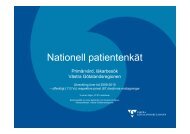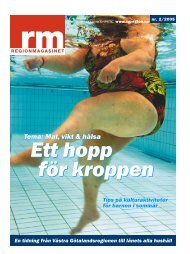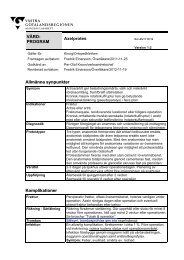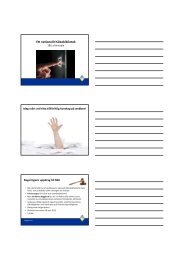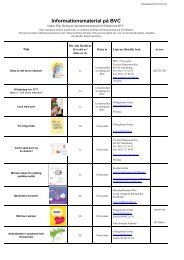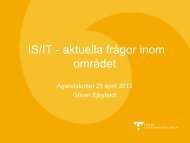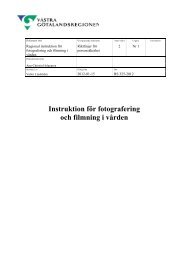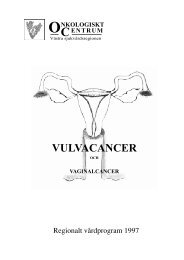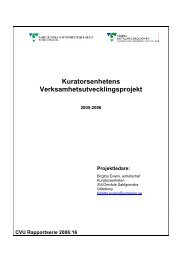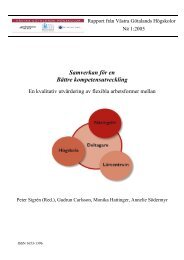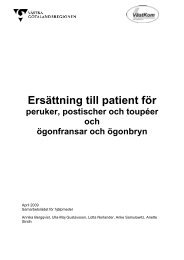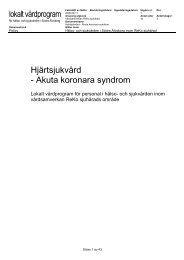FOURTEENTH ANNUAL EUROPEAN PRESSURE ULCER ...
FOURTEENTH ANNUAL EUROPEAN PRESSURE ULCER ...
FOURTEENTH ANNUAL EUROPEAN PRESSURE ULCER ...
You also want an ePaper? Increase the reach of your titles
YUMPU automatically turns print PDFs into web optimized ePapers that Google loves.
Thursday September 1st<br />
Proceedings of the 14th Annual European Pressure Ulcer Meeting<br />
Oporto, Portugal<br />
Wound Models in Monolayer Cell Cultures,<br />
Quantitative Analysis of Cell Kinematics<br />
Amit Gefen * , Orna Shaharabany-Yosef, Gil Topman<br />
* Department of Biomedical Engineering, Faculty of Engineering, Tel Aviv University, Israel, gefen@eng.tau.ac.il<br />
Introduction<br />
Cell migration is a critical process in wound<br />
closure, including closure of pressure ulcers (PU).<br />
Wound healing assays are simple but effective<br />
means for studying cell migration in vitro, and<br />
such assays were found to represent the<br />
kinematics of in vivo migration to a reasonable<br />
extent. In wound healing assays, cells migrate<br />
from a populated area into a denuded area,<br />
created e.g. by local crush, scratch or ablation of<br />
the cells, and hence the "wound" is covered. One<br />
of the commonly used measures for the<br />
performances of the migrating cells is the area of<br />
the "wound" over time, and in particular how fast<br />
can that area be covered by cells post infliction of<br />
the damage. However, current methods that are<br />
available for measuring the area-time behavior of<br />
the "wound" are typically subjective and<br />
inaccurate, or costly, or cumbersome to apply.<br />
Here we present a new method, based on timelapse<br />
digital optical microscopy and image<br />
processing, for quantifying the kinematics of cell<br />
colonies migrating from populated areas into a<br />
denuded area, in the context of modeling cell<br />
migration in PU healing. In particular, we<br />
employed our new method for determining the<br />
migration kinematics of different cell types which<br />
can be potentially involved in PU healing<br />
(fibroblasts, preadipocytes and myoblasts) as well<br />
as for characterizing effects of ischemic factors<br />
associated with PUs (low glucose, low<br />
temperature and acidosis) on the migration.<br />
Methods<br />
NIH 3T3 fibroblasts, 3T3-L1 preadipocytes and<br />
C2C12 myoblasts were thawed from liquid<br />
nitrogen storage and cultured in standard media<br />
that are specific to each cell type. When cultures<br />
were near confluency, a micro-indentor (size<br />
0.46×0.38mm) was used to inflict localized<br />
crushing damage to the cultures. Time-lapse<br />
images of the cultures were then acquired every<br />
2 hours, using an Eclipse TS100 microscope<br />
(Nikon) and DS-Fi1 digital camera with a<br />
resolution of 2560×1920 pixels (3 pixels per<br />
micron). During image acquisition, cultures were<br />
kept at 37ºC using a temperature control system,<br />
and HEPES was supplemented to the media in<br />
order to control the pH level. The time-dependent<br />
micrographs were post-processed by a MATLAB<br />
46<br />
code, based on texture homogeneity measures.<br />
Specifically, denuded areas in the digital<br />
micrographs were characterized by a<br />
substantially lower standard deviation (SD) of<br />
pixel intensities, as opposed to cell-populated<br />
areas where the SD of pixel intensities was high.<br />
The SD distributions were mapped over the<br />
micrographs per each time point, using two<br />
window sizes for each cell type: the first being a<br />
window with a course resolution and the second<br />
with a fine resolution. An intersection of these SD<br />
distribution maps obtained when using the two<br />
window sizes resulted in an adequate<br />
measurement of the time-dependent area of the<br />
denuded region. The experimental area vs. time<br />
data were finally fitted to Richards nonsymmetrical<br />
sigmoid functions for calculating<br />
migration rates from the coefficients of these fits.<br />
Results<br />
Cells covered the damage area after ~24 hours,<br />
however there were cell-type-dependent<br />
differences in rates of coverage. Specifically,<br />
fibroblasts and the fibroblast-like preadipocytes<br />
(3T3-L1) were faster than the myoblasts in<br />
covering the damage area under control culture<br />
conditions (37ºC, glucose=4.5g/ml, pH=7.4). The<br />
migration rate of the NIH3T3 fibroblast cells was<br />
reduced by ~50% at an acidic environment<br />
(pH=6.7) but the other cell types were not<br />
significantly affected by the acidosis.<br />
Discussion<br />
Developing a reliable and reproducible wound<br />
healing model in vitro is essential for studies of<br />
the etiology of PU as well as for testing the<br />
performances of any medication or food<br />
supplement aimed at improving cell motility for<br />
wound healing. The present method meets these<br />
needs and is easy to implement in a cell lab.<br />
Clinical relevance<br />
A reliable, reproducible wound model system is<br />
essential for testing medications and food<br />
supplements claimed to improve healing of PU.<br />
Conflict of Interest: None<br />
References<br />
Topman, G., Shaharabany-Yosef, O., Gefen, A. A method<br />
for quantitative analysis of the kinematics of fibroblast<br />
migration in a monolayer wound model. Proceedings of the<br />
ASME 2011 Summer Bioengineering Conference,<br />
Farmington, PA, USA, June 22-25, 2011.<br />
Copyright © 2011 by EPUAP



